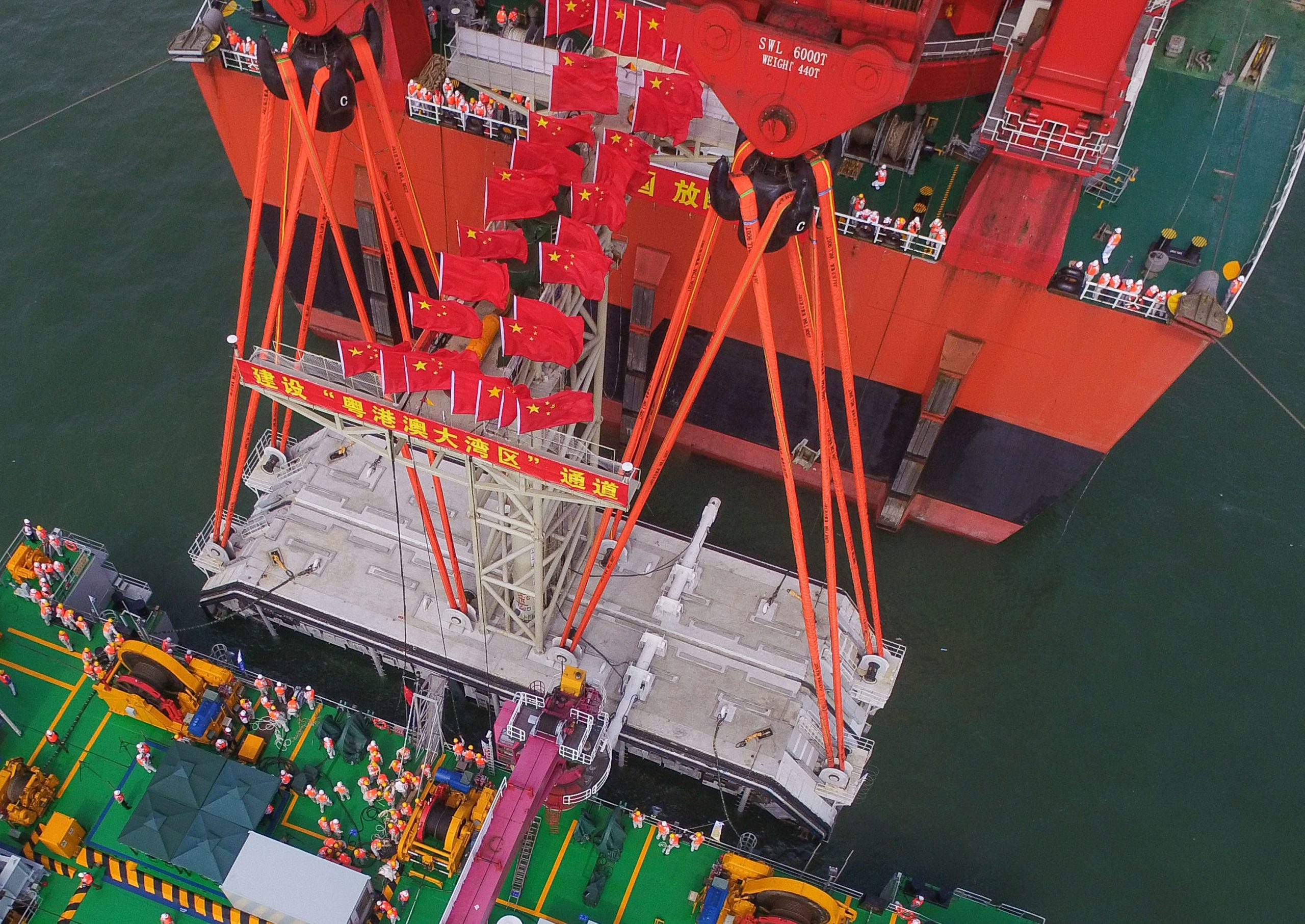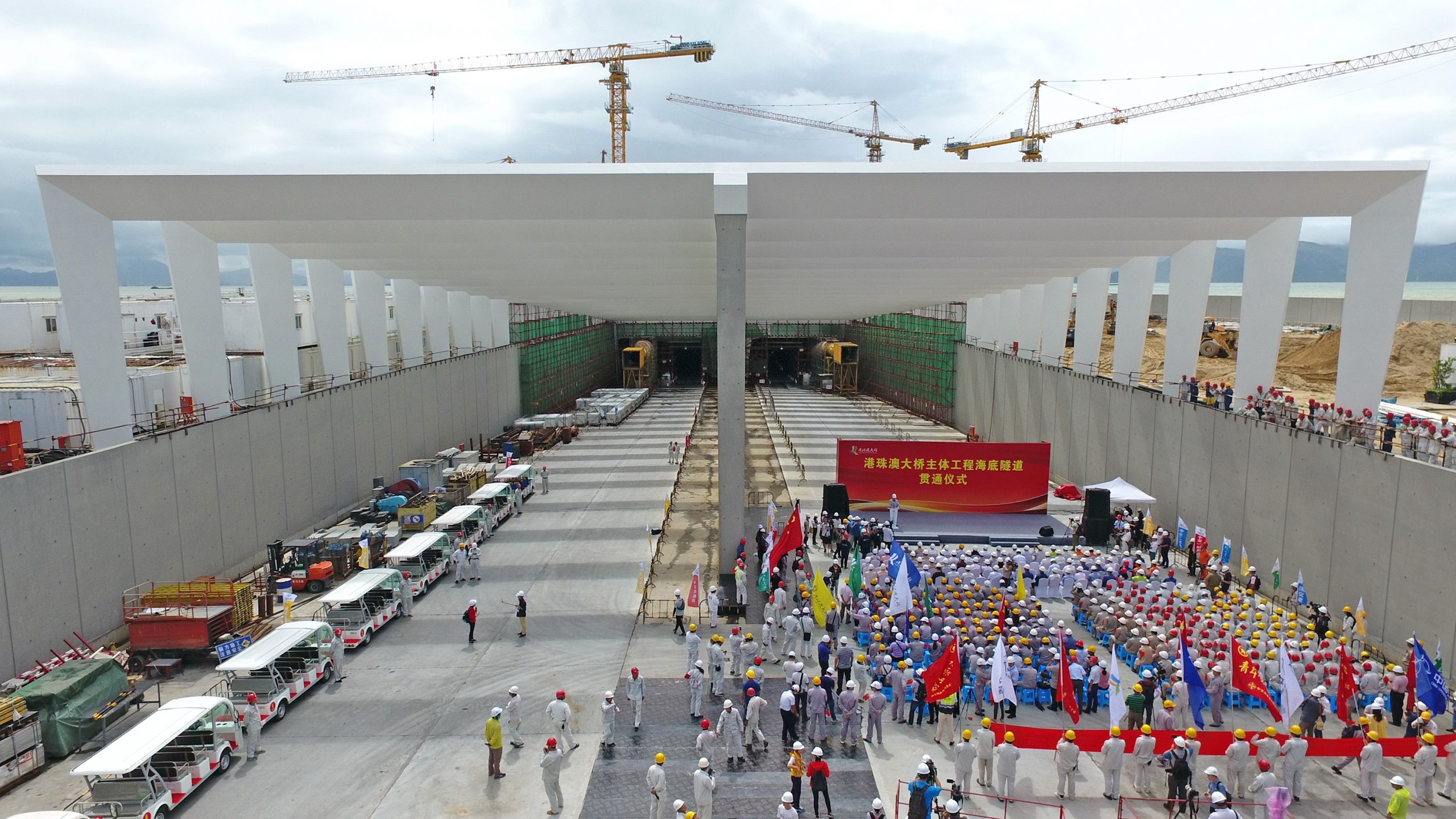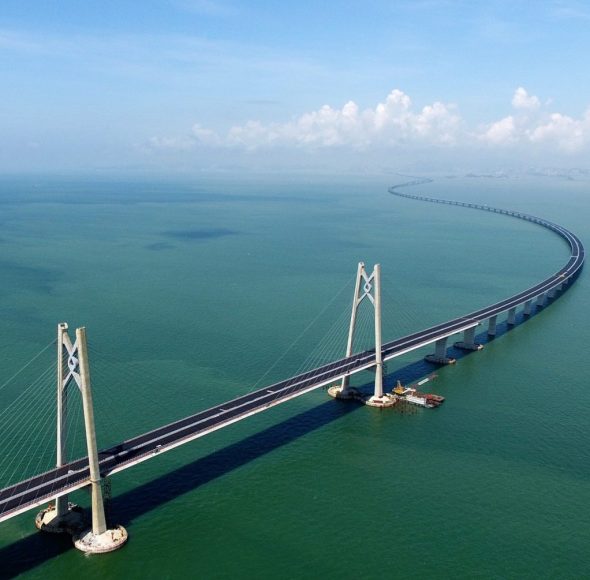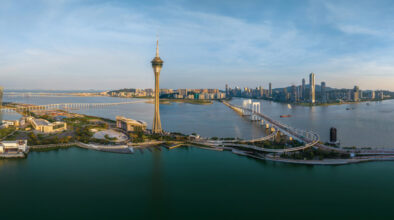PHOTOS Xinhua News Agency, Cheong Kam Ka and Leong Kin Wa
Enhanced connectivity between the three cities is an important step in developing the Greater Bay Area of Guangdong
The Hong Kong-Zhuhai-Macao Bridge (HZMB) the first road link in China’s history to connect the three cities, is expected to open in 2018. None of the three governments has given an opening date as it will be up to the central government in Beijing to make the final decision and announcement.
With a total length of 55km, it is the longest and most technically difficult bridge in all of China. It is also the most expensive, estimated at more than US $17 billion. A 6.7‐km underwater tunnel section, the longest sea tunnel in the world, crosses under the busy shipping lanes and strong currents of the Pearl River. To create it, builders laid 33 sections of tunnel on the bed of the river, each weighing as much as an aircraft carrier, and joint them seamlessly. The tunnel, the deepest of its kind at 48 metres underwater, transitions into a 22.9‐km bridge. Taken in total, the HZMB is easily the longest sea bridge in the world. A remarkable engineering feat made that much more challenging in a region struck each year by powerful typhoons.
The new bridge will strengthen the connection between the three cities, making access between them faster and more convenient. It will have a profound economic effect on tourism, retail, property and the movement of goods, and give residents the option to live in one city and work in another.

Enhancing connectivity between Macao, Hong Kong, and Zhuhai in mainland China is an important step in constructing the Guangdong– Hong Kong–Macao Greater Bay Area, which groups nine cities in the Pearl River Delta (PRD) with the two Special Administrative Regions (SARs) into one thriving megalopolis.
The bridge, first mentioned in 1983, took decades to plan and about eight years to build, starting construction in December 2009. For all it promises to draw the region closer together, furthering integration of the two SARs with the mainland, it comes at a steep price – the cost is being shared between the three parties – the Hong Kong SAR government, 42 per cent, the Macao SAR government, 13 per cent, and the Guangdong provincial government, 45 per cent. Thousands of workers, Chinese and foreign, have been involved in the construction.
The biggest impact of the bridge will be to accelerate the integration of Hong Kong and the western PRD. Hong Kong and foreign companies have long concentrated investment in cities along the rail and road corridor to Guangzhou, turning it into the “factory of the world.” The HZMB creates for the first time a rapid road connection between this area of the PRD and Hong Kong’s international airport (HKIA) and seaport.
In 2016, HKIA handled 4.52 million tonnes of air cargo, making it first in the world for cargo for the seventh consecutive year. Of its cargo, high‐value items that must be shipped quickly account for less than 10 per cent by volume but 40 per cent by value. The main items are fresh food, flowers, fashion, electronic goods, and pharmaceuticals.
Producers of these goods in the western PRD, Hainan, Guangxi, and other areas of the southwest will be able to ship such items more quickly to the HKIA. The bridge promises to cut the current travel time between Zhuhai and the HKIA from about four hours to 45 minutes. Such a drastic decrease in travel time will encourage companies to locate manufacturing in these areas.

Then there’s passenger traffic: HKIA handled 70.5 million passengers in 2016, up 3 per cent from the previous year, maintaining its position as eighth in the world. It connects to 220 destinations, including 50 in the mainland, and handles more international passengers than the top five airports in the mainland combined.
Welcoming Visitors
The greatest beneficiary in Macao will be the tourism industry. Visitors from Hong Kong and mainland China account for the majority of visitors to Macao, 86.8 per cent in 2016, and most travel to the city via Hong Kong. The bridge will offer them an alternative to the current ferry services. That increased accessibility complements the ambitious goal set out by the Macao Government Tourism Office (MGTO) of 40 million visitors by 2025. More visitors means more customers for the city’s hotels, casinos, restaurants, and shopping malls.
Creating more access points also serves to alleviate congestion at existing cross‐border checkpoints, another concern addressed by the MGTO in their recently released Tourism Industry Master Plan.
But accessibility comes with a price: drawing more Hong Kong and mainland buyers into the local property market will push prices even higher. In a city as compact as Macao, space is always at a premium.

Zhuhai Seizing Opportunities
Zhuhai has been preparing aggressively for the opportunities associated with becoming the first mainland city with a land connection to both SARs via the new bridge.
At an investment promotion event in August, the city announced the construction of the Zhuhai– Hong Kong–Macao Cooperative Logistics Park. It aims to function as the logistical centre for the two SARs and the whole west side of the PRD, including Zhongshan, Jiangmen, and Heshan. The park, slated for an 800,000 square metre lot, will be the centre of the planned 26 square kilometre Hong Kong– Zhuhai–Macao Bridge Economic Zone within the Hengqin New Zone (HNZ).
The HZMB Economic Zone will develop a number of key business forms, from warehousing logistics to cross‐border e‐commerce to tourism. The city’s largest source of foreign investment is Hong Kong with US$26 billion in 1,535 ventures, explained Zhuhai Vice‐Mayor Lu Xiaofeng. Of these, 668 are in the HNZ, with a registered capital of CNY79.2 billion (US$11.9 billion). Yang Chuan, director of the HNZ management committee, sees a bright future for the zone:
With the opening of the bridge, the HNZ can use the advantages of Hong Kong’s airport, logistics and financial services and, with the bridge, drive the flow of people, goods, capital, and information.”
Transport has always been the Achilles’ heel of Zhuhai. First established as a Special Economic Zone (SEZ) in 1980 due to its proximity to Macao, Zhuhai developed more slowly than the two SEZs of Shenzhen and Xiamen. Without a land connection to Hong Kong or a rail link to the rest of China, Zhuhai couldn’t compete at the same level. The recent additions of a passenger rail line in 2011, and a cargo line at the end of 2012, will be greatly augmented by the direct land connection to Hong Kong offered by the HZMB.
In 2016, Zhuhai posted GDP of CNY223 billion (US$33.5 billion), a rise of 8.5 per cent over 2015, with utilised foreign investment of US$2.3 billion, up 5.4 per cent. The city’s main industries are electronic information, bio‐pharmaceutical products, electrical appliances, electrical energy, petrochemicals, and precision machinery. Officials expect the new land link will attract more investment from Hong Kong, especially in high‐end manufacturing, new and high‐tech industries, marine economy, eco‐agriculture, and traditional Chinese medicine.

Officials also see the new investment and closer connections spurred by the bridge as an opportunity to revitalise the Zhuhai Jinwan Airport in Sanzao township, 37 km from the city centre. It’s been running well below capacity since it opened in June 1995. In 2016, it handled 6.13 million passengers, compared to its design capacity of 12 million. Since August 2006, HKIA has held a 55 per cent share in a joint management company with the Zhuhai government; the company has the exclusive right to manage and operate the airport for 20 years.
Eager to utilise its spare capacity, the airport is looking into augmenting HKIA, handling cargo and passenger planes and business jets for which there are no parking places at the congested Hong Kong airport. The new bridge makes such plans more feasible – less than an hour’s drive to Hong Kong – if still complicated: the two airports fall under different legal jurisdictions and separate air service agreement regimes.
Expanding Education
Zhuhai’s ambitions aren’t limited to industry. The same investment promotion event saw an announcement that the elite British Harrow School will open a campus in Hengqin on an area of 50,000 square metres. Due to open in 2020, the school will take 1,000 students, from kindergarten to secondary school. The Harrow campus in Tuen Mun, which opened in 2012, has 1,180 students enrolled.
The construction of another British boarding school, Wycombe Abbey International School, was announced by officials in August. The co‐ed, full boarding school is due to open in 2019, offering the national curriculum of England and Wales to more than 1,000 students from kindergarten to secondary school. With the new land connection, officials expect both schools to draw in students from across the Greater Bay Area.
For all the prosperity promised by the HZMB, there are significant limitations on its use and financial viability. While cargo vehicles will face no restrictions, authorities will initially restrict the use of private vehicles on the bridge. Dense traffic in Zhuhai and the two SARs mean none welcome a large increase in vehicles. Most people will cross the bridge using direct coach services and shuttle buses.
Drawing more Hong Kong and mainland buyers into the local property market will push prices even higher. In a city as compact as Macao, space is always at a premium
November 2017

The Hong Kong Transport Department, working in conjunction with Guangdong announced that it would issue a quota of 3,000 new cross‐border licences for private cars travelling in both Hong Kong and Guangdong. There will be an additional quota of 300 such licences for private cars from the mainland. Nearly 28,000 vehicles in Hong Kong and 3,000 in the mainland already have cross‐border licences.
No announcement yet on tolls for vehicles or fares for those using the buses has been made. Prices for the current ferry services range from about HK$153 (US$19.62) to HK$713 (US$91.41) depending on time of day and quality of accommodations.
Many travellers will use shuttle buses to travel to two giant man‐made islands outside Macao and Hong Kong where they will pass through immigration and customs before continuing their journey on locally registered vehicles. The island off Macao has 3,000 parking spaces, the one-off Hong Kong only 650.
Recovering their Investment
This restriction of the number of vehicles raises questions over when, if ever, the HZMB will recover the enormous investment made by Macao, Hong Kong, and the central government. Construction delays and overspending drove up the cost of an already expensive project; engineering milestones rarely come cheap or easy. During the extended construction period, work on two other bridges over the Pearl River began. The Second Humen Bridge, 60 km north of Hong Kong, is scheduled for completion in 2019 and the Shenzhen–Zhongshan Bridge, 30 km north of the HZMB, should be completed in 2023. Both will offer an alternative and possibly cheaper routes across the river.
Fang Zhou, chief research officer at the Hong Kong‐based One Country Two Systems Research Institute, explained that delays in beginning construction of the bridge gave cities in the PRD time to greatly develop their port capacity. Exporters in the delta no longer need to use the port of Hong Kong. He added that the other PRD bridges will offer lower tariffs than the HZMB, while the existing cargo barges to Hong Kong are even cheaper still.
Additionally, the door‐to‐door travel time on the HZMB will be as long or longer than going by ferry, as passengers will be required to disembark to pass through two immigration and customs inspections. “In terms of time and convenience, the bridge is not so competitive,” Fang said.
Ferries between Macao and Hong Kong leave every 15 minutes during daytime hours, and completing immigration and customs formalities is a matter of minutes at both ends. Officials will need to fast‐track the process at bridge checkpoints and provide a comprehensive schedule to compete effectively.
Maria Helena de Senna Fernandes on the implications and impact of the bridge for the city and region
Macao Magazine: What impact will the new bridge have on tourism in Macao? Will it increase the number of visitors from Hong Kong (HK) and the mainland via HK?
Maria Helena de Senna Fernandes: The Hong Kong– Zhuhai–Macao Bridge will significantly reduce travel time between the three regions, and allow for the exploration of new multi‐destination tourist routes and intensification of the circulation of tourists. Given the mutual advantages of the three regions, it is favourable to achieving the goal of transforming Macao into a World Centre of Tourism and Leisure and also promoting sustainable tourism development in the three regions.
MM: Is the bridge a factor in your projection of 40 million tourists by 2025?

MHSF: The Hong Kong–Zhuhai–Macao Bridge is one of those important infrastructure projects for the future tourism development of Macao. Several other major infrastructure projects are underway or planned, which are expected to remarkably improve Macao’s accessibility and the transport link with mainland China, such as the new Guangdong–Macao Channel and the expansion project of Macau International Airport. The closer collaboration between Macao and its regional partners has enhanced the development of multi‐destination and other tourism projects such as the Free Yacht Travel Scheme. Moreover, the defined maritime areas have provided a strong foundation for Macao to develop leisure and recreational facilities and activities in the field of maritime tourism while the future new reclamation areas will provide opportunities to bring a diversity of new tourism elements to Macao.
MM: Will the tourists use large buses instead of ferries? Do you expect a sharp reduction in ferry services between HK and Macao?
MHSF: Direct road access from Hong Kong to Macao via the Hong Kong–Zhuhai–Macao Bridge will become a potentially cheaper and convenient option for travellers, and yet it is still at an early stage to estimate the actual pattern of travel behaviour.
MM: Recognising the opportunities provided by the bridge, is MGTO planning activities targeting consumers, media, and trade?
MHSF: Yes. At the consumer level, we feature the bridge in travel fairs, events, TV travelogues, and roadshows to enable different market segments and stakeholders to learn more about it. Prime locations will be used to organise roadshows to maximise exposure, with photo/drawing/bricks competitions to associate consumers’ imagination with the bridge.
We will also distribute press releases, media updates, and media outreach/pitching, utilising online, social, and traditional media to enhance the exposure of the bridge in order to increase public awareness.
MM: Do you plan to promote the new link between HK, Zhuhai, and Macao abroad?
MHSF: We plan to promote the bridge in travel trade publications, including information in Macao sales guide, and update travel trade partners during destination presentations and seminars. Information on the bridge will also be included in e‐shots to the travel trade, future travel industry training and sales activities, and updated online training scheme. We will support trade‐focused promotional campaigns and jointly work with partner travel agencies and airlines in introducing commemorative tours featuring the use of the new bridge.
We will also send invitations to major travel associations in various markets to announce opening of the bridge, and organise familiarisation trips for trade so they can include it in their Macao and multi‐destination tour packages.



